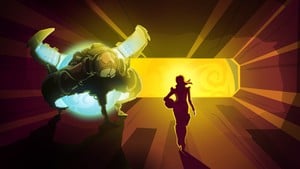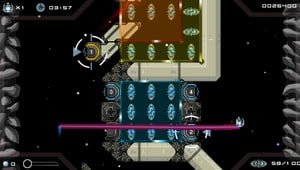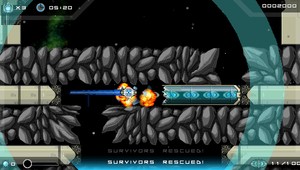
Coconut Dodge is easily one of the strongest titles on the PlayStation Minis platform. FuturLab’s cunning combination of puzzle and arcade gameplay culminated in one of the most additive games of 2010. Naturally, we’re pretty excited about the studio’s next project: Velocity.
On the back of today’s announcement, we sat down with FuturLab’s managing director, James Marsden, to talk PlayStation Minis, teleportation and avoiding the sophomore slump.
Push Square: First up, please could you give us the elevator pitch for Velocity?
James Marsden: Velocity lives up to fond memories of the shoot ‘em-up classics, and goes several steps further by giving you something totally new and exciting — teleportation!
PS: Coconut Dodge, your last project, released way back in 2010 on the PlayStation Store. Given that PlayStation Minis traditionally operate on a shorter development cycle, is there any particular reason we’ve been waiting so long for Velocity to arrive?
JM: It has genuine gameplay innovation, and that requires a lot of hard work to get right. We put creative integrity at the forefront of what we do, so we’ve taken our time to make the best game we can on a very limited budget.
PS: It’s fair to say that Coconut Dodge became something of a cult hit post-release. How are you coping with the pressure of following up such a successful game? Is it at the back of your mind at all?
JM: I have to be honest here and say that Coconut Dodge got to where it did partly by being a good game, but also because I worked my ass off to put it under people’s noses in an interesting and entertaining way. I could draw on a graph all the points of interaction we made with the press, and gamers, and publishers, which made Coconut Dodge the success that it was. If we’d just released it and sat back and crossed our fingers, it would have gone the way of most other Minis, I’m pretty certain.
So no, I have never felt under pressure about following up on Coconut Dodge’s success, because we made that game successful through our actions – so we can do it again, and we can take Velocity much further, because there’s so much more to work with than a crab on a beach.
PS: Velocity’s got a very old-school arcade vibe to it. Why did you decide to head in that direction, and are there any titles in particular that influenced the game’s visual style?
JM: It’s partly been necessity. We’d love to show people what we can do with Unreal and about 10 million quid, but we have to be realistic about what we can achieve as a small team.
We’d love to show people what we can do with Unreal and about 10 million quid.
The other side is there are lots of games from the 80s and 90s that can be re-imagined successfully. Coconut Dodge was essentially ‘KABOOM!‘ with some new design elements.
In terms of visual style, that was largely down to Mr. John Steels, who created the large majority of the artwork. I initially wanted to have a vector style, but he correctly pointed out that the scale of our world on PSP would look crap in vector, and proceeded to draw it all in a pixel art style. I took one look at what he was doing and loved it immediately, so we ran with that. Pixel Art has been cheapened over the years by people who can’t really do it that well, but John is a veteran master and I think when you get the game in your hands, you’ll appreciate all the pixel-perfect details – the pipes and grills and little lights and things – it’s awesome.
PS: FuturLab’s company-wide philosophy hinges on the idea of accessible games with clever twists. In Velocity, that twist comes from the fact that you can teleport. Can you elaborate a little bit on how the mechanic will work in-game?
JM: Short Form Teleport (SFT) as we call it, allows players to position a teleport cursor anywhere on screen by holding [the Square button], which brings up the cursor on top of the ship, and then the player moves it with the Analog Stick or Directional Buttons to choose a destination. The player then lets go of Square to teleport instantly.

Written down like that it sounds a bit cumbersome, but it is exactly the same as using Turbo in Coconut Dodge.
Want to go a little faster in this direction? Hold the button, move there, let go again. You can teleport to the other side of the screen and back again so quickly that someone watching you will wonder what’s going on and say: "Give us a go then".
This mechanic gives us huge potential for more interesting fire fights, spatial puzzles, and the insta-fun of just being able to hop around the screen any time. SFT is the toy at the heart of the game that everyone can enjoy, no matter the difficulty level, and everything else has been built around it.
We’ve also spent a long time refining the feel of SFT. We found the sweet spot, and then designed our levels based on that sweet spot. All the levels have been designed in the last three months, after nearly two years of getting to know what works and what doesn’t work for a player. I think we’ve nailed it.
PS: Players can also return to previous parts of a level using Telepods. What are the advantages of doing this? Can we expect many puzzles in addition to the action?
JM: The advantages are that players can go back and see what they missed, try a different route, and solve puzzles. Some levels require multiple passes, doing different things on each pass to unlock a goal.
The real advantage though is behind the scenes for us, in the scope for level design, because we are able to design levels that are more interesting to play through than just flying around and shooting stuff. The levels are split into three types: Attack, Rescue and Speed.
Attack levels are just that – you shoot stuff – these are levels that are closest to your traditional R-Type-esque shooter levels, albeit with some teleport gymnastics and bomb flinging challenges thrown in to keep things interesting.
There are moments where a player is going to feel clever for working out very simple spacial puzzles.
Speed levels are the evolution of Coconut Dodge mazes – they are all about muscle memory, and they're fast!
Players will need to memorise exactly when to teleport, when to fling a bomb, when to drop a telepod and when to return it. These levels are quite short too, so that the repeated trial and error necessary doesn't get annoying – a bit like Coconut Dodge mazes – you know you got near the end that time, so you're just going to have one more go.
Rescue levels take place on a much wider area, and usually feature the most puzzles. We've got some nice little puzzles, not too many though – it's mostly about the action – but we're able to drop in cool little things here and there to keep a player on their toes.
Something that has always bothered me about shooters is the fact that I should love them – I love the ships, the futuristic styles, the music quite often, the idea of blasting your way though to some alien metropolis – all of that stuff ticks big boxes for me - but I find them dull. They're so one-dimensional.
We wanted to push the genre in a new direction, and this teleporting aspect allows us to do that in subtle ways that will hopefully bring a smile to people's faces. There are moments where a player is going to feel clever for working out very simple spacial puzzles, but quickly enough to avoid being crushed by the scrolling terrain, or they'll learn to drop a telepod at a certain place to shave seconds off their best time. We're very proud of those moments.
PS: As we’ve just established, Velocity includes a lot of innovative mechanics – many of which are completely new to the genre. Was it difficult striking a balance between innovation and accessibility, and how does the game school players that are picking it up for the first time?
JM: It was very difficult to strike a balance, and that's another reason why the game has taken a long time to develop. We have this great toy in the teleport control, which is very powerful, and it's easy to get carried away with that. We also use every button available on the PSP. You can control the speed of the scrolling world, so it's a lot more like a racing game than a shooter. You can also fling unlimited bombs at will. The Quarp Jet turns the player into a nippy little bad-ass, so some of our earlier level designs were ridiculously technical.
That's no fun for the person coming to it for the first time though, so we ramp up slowly, giving players plenty of time to get to grips with each mechanic as it is introduced. This is largely thanks to Kirsty (Rigden), who has a ton of experience designing levels for all kinds of games from Racing to FPS. She can totally get inside the head of a player, whereas I'm a bit too eager to show the player all the cool stuff straight away.
The way we've divvied up the design is Kirsty designed levels from 1 upwards, and I designed the tougher levels from 50 downwards. Our plan was to meet in the middle, with a few levels designed by other members of the team to add some flavour diversity. That's worked very well going by the focus test we ran recently.
PS: You worked with Joris de Man, the award winning Killzone composer, on Velocity’s soundtrack. Can you tell us a little bit about this process; how did you hook up with Joris in the first-place, and what was it like working with such a recognised name?

JM: It's been a real pleasure working with Joris. He is a total professional, and very talented. We also seem to be on the same wavelength which has been hugely exciting. I've been a bedroom music producer since Uni, so I wrote the musical ideas for Velocity over many months (one of the tracks I wrote whilst at Uni 10 years ago), but they were never going to sound as good as they needed to, so I asked Joe if he'd work his magic on them, and fortunately for us, he was well into it.
The game has a retro vibe, and he used to do chip tune music - that's where his career began – so I think he found that aspect appealing; revisiting his stomping ground, but with a whole new set of techno-toys to play with.
He's taken my humble recordings and added so much depth, polish and emotional energy. It's the perfect soundtrack for saving the galaxy! A proper 80s epic, but with modern sounds. I love it.
As for how we hooked up, I worked with a guy who had designed Joris' website, so I was really impressed by that as I was a big fan of the Killzone music, and it turned out they played basketball together, with Joris living just 5 minutes from our office – so we got together and talked about synths, and played some Street Fighter. I hope we can work on something together again, because it's been amazing for me.
PS: With the greatest of respect to the other titles on the platform, Velocity goes way beyond the expectations of most other PlayStation Minis. You’re touting 50 levels, mini-games, Joris de Man, a custom trophy system and more. What’s keeping you on the PlayStation Minis platform at this stage? Was releasing the game on the PlayStation Network ever a possibility?
JM: Velocity began as a 'pet-project', alongside other games that were in development last year – Coconut Dodge for EA, a huge Flash project, and a game that was unfortunately canned, so we never approached Velocity as being a larger product.
However, around July last year we realised that the game was bigger than Minis, both in ambition and in depth, so we shopped it around to publishers to see if we could get a bite on PS PS Vita.
Unfortunately our timing wasn't great, because PS PS Vita doesn't have an install base yet. Publishers with the kind of muscle to risk a project on an unproven platform had already allocated their spend for PS PS Vita, so they said come back next year. Well, we can't wait for that, so we thought let's go ahead and self publish on Minis, see if we can build a following, and then try again with publishers for a sequel or HD reboot once PS VITA has established itself.
You and your readers are now in possession of FuturLab's business plan for 2012.
PS: On a more general level, you’ve been pretty big evangelists of the PlayStation Minis platform in the past. Some would argue that the label’s been a disappointment. What would you say to those critics and what do you think it’s going to take to change perception of the platform?
We thought Velocity was a perfect fit for PS Vita.
JM: I think there are some total gems on the platform, and some utter crap. As I mentioned before, FuturLab is using Minis as a springboard to show what we can do, whereas I think a lot of developers are churning clones to make a quick buck. I've not really been paying much attention to other games on Minis lately, as I've been so busy – but from what I saw last year, only Mediatonic impressed me. They made the platform look great in my opinion.
A platform is only as good as the developers that are on it, so I'm hoping that PS Vita is able to attract a better class of developer – studios with some creative integrity at their core.
I should apologise to any studios that have put their hearts into their games on Minis – I know there are lots that I haven't played. But those studios who have just churned the clones, you know who you are.
PS: And finally, we have to ask, what are your plans for the PlayStation PS Vita at the moment?
JM: We thought Velocity was a perfect fit for PS Vita, but our timing was off. Let's see how much of a following we can build for this version, and then we'll take it back to the big boys and see if we can get something signed.
PS: Thanks so much for taking time out of your busy schedule to chat with us.
JM: Thanks, I've enjoyed it. Also congratulations and good luck on the new Push Square, it looks fabulous, and it's great to see all the new content coming thick and fast!
Comments 5
I was getting ready to say how perfect this would've been for the Vita..... Would've made a great launch title... seems so pick up and play friendly. Hope they can do something in the future
I wish I was better at these shmups!
Shmup.... sounds dirty, and complicated
@antdickens Velocity isn't like other shmups, you don't have to rule at bullet-hell to enjoy it - There's more to it for a wider audience, as this lass describes nicely: http://www.gamercast.net/velocity-preview
This looks fantastic! Slappy smuckin' luvz him some smups!
Show Comments
Leave A Comment
Hold on there, you need to login to post a comment...